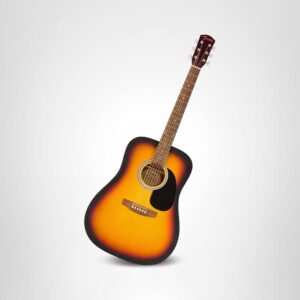Comprehensive Review: Fender FA-25 Dreadnought Acoustic Guitar
Verdict: The Fender FA-25 is a quintessential “first guitar.”
It prioritizes durability and ease of play over tonal complexity, making it an excellent choice for absolute beginners, students, or travelers who need a worry-free instrument.
While it lacks the richness of a solid-top guitar, its price-to-performance ratio is hard to beat for those on a strict budget.
1. At a Glance
- Target Audience: Beginners, students, travelers, and casual players.
- Price Range: Budget / Entry-level (typically ~$150 – $200 USD).
- Key Feature: “C”-shaped neck profile designed for comfort.
2. Technical Specifications
| Feature | Specification |
|---|---|
| Body Shape | Dreadnought (Full size) |
| Top Wood | Laminated Spruce |
| Back & Sides | Laminated Basswood or Mahogany (varies by specific run) |
| Neck Material | Nato or Mahogany |
| Neck Profile | “C” Shape |
| Fingerboard | Walnut |
| Scale Length | 25.6″ (650 mm) |
| Frets | 20 |
| Bridge | Walnut |
| Tuners | Sealed Die-Cast |
| Finish | Satin (available in Natural, Sunburst, Black) |
3. Build Quality and Design
The FA-25 is part of Fender’s “Alternative” series, which focuses on affordability.
- All-Laminate Construction: The entire body is made of laminate woods. While this is often seen as a negative by purists because it vibrates less freely than solid wood, it offers a distinct advantage for beginners: durability. Laminate is much more resistant to changes in temperature and humidity, meaning this guitar can survive a car trunk or a campfire without warping or cracking as easily as a high-end instrument.
- Aesthetics: Fender does a great job of making budget instruments look professional. The satin finish is smooth to the touch and doesn’t show fingerprints as badly as gloss finishes.
- Hardware: The sealed die-cast tuners are a highlight. In this price range, cheap tuners often slip, causing frustration for new players. The FA-25’s tuners generally hold pitch well after the strings have settled.
4. Playability
This is the most critical category for a beginner guitar. If it hurts to play, the student will quit.
- The Neck: The modern “C”-shaped neck is the guitar’s strongest selling point. It is slim and comfortable, preventing the hand fatigue that often plagues new players dealing with “baseball bat” style necks found on older cheap guitars.
- Action (String Height): Out of the box, the action is usually acceptable but may be slightly high. A high action forces the player to press harder to fret notes. Recommendation: If you buy this guitar, ask the shop to perform a basic setup, or learn to adjust the truss rod (wrench usually included) to lower the action slightly.
- Fretwork: As is common with budget guitars, the fret edges can sometimes feel a bit sharp or rough. This doesn’t affect the sound but can be annoying. A simple sanding sponge can smooth these out in minutes.
5. Sound Performance
- Tone: Because of the laminate construction, the sound is somewhat “boxy” or compressed compared to a solid spruce top guitar (like the Yamaha FG800). However, it is still pleasant. The spruce top provides decent brightness, while the dreadnought body shape ensures a bold, loud projection.
- Bass Response: Dreadnoughts are known for bass, and the FA-25 delivers a respectable low end, though it can lack the deep, booming resonance of higher-tier woods.
- Sustain: Sustain is average. Notes decay faster than on a solid wood guitar, but for strumming chords (which is what 90% of beginners do), it is perfectly adequate.
6. Pros and Cons
Pros
- Durability: Laminate build withstands humidity and temperature changes well.
- Comfort: The satin finish and C-shape neck are very forgiving for new hands.
- Brand Value: It holds its resale value slightly better than generic “Amazon brand” guitars.
- Visual Appeal: Looks like a much more expensive instrument.
- Extras: Often sold in bundles that include a gig bag and access to Fender Play lessons.
Cons
- Laminate Top: Sound quality is limited; it will not “open up” or improve with age like a solid wood guitar.
- Setup Required: Likely needs a truss rod adjustment out of the box for optimal playability.
- Sharp Fret Ends: Quality control on fret finishing can be inconsistent.
7. Comparisons
vs. Yamaha F310
The Yamaha F310 is the direct competitor.
The Yamaha often has slightly better consistency in quality control, but the Fender FA-25 feels slightly more modern with its neck profile.
Both are laminate guitars and sound very similar.
vs. Yamaha FG800
If your budget allows you to stretch about $50-$80 more, the Yamaha FG800 is a significantly better instrument.
It features a Solid Spruce Top, which produces much better volume, sustain, and tone. If you are serious about learning, the FG800 is the better long-term investment.
vs. Fender FA-115 / FA-125
The FA-25 is very similar to the FA-115 and FA-125.
The differences are often minor cosmetic changes, slightly different neck woods (Nato vs. Mahogany), or bundle inclusions.
Practically speaking, they play and sound nearly identical.
8. Final Thoughts
The Fender FA-25 is not a “forever guitar,” but it isn’t trying to be.
It is a tool designed to get you from “I want to play” to playing your first song without breaking the bank or discouraging you with a difficult neck.
If you have exactly $150 to spend, this is a safe, reliable choice.
If you can afford $250, look for a solid-top guitar (like the Yamaha FG800 or Fender CD-60S), but for the absolute entry-level bracket, the FA-25 is a solid contender.


